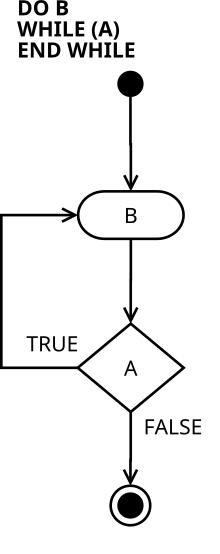
Back Bucle do while Catalan Cyklus do-while Czech Schleife (Programmierung)#Do-While-Schleife German Bucle do Spanish Repeat begizta Basque Do while petlja Croatian Do-while文 Japanese Do-while 루프 Korean Gelung do while Malay Do while petlja Serbo-Croatian

| Loop constructs |
|---|
In many computer programming languages, a do while loop is a control flow statement that executes a block of code and then either repeats the block or exits the loop depending on a given boolean condition.
The do while construct consists of a process symbol and a condition. First the code within the block is executed. Then the condition is evaluated. If the condition is true the code within the block is executed again. This repeats until the condition becomes false.
Do while loops check the condition after the block of code is executed. This control structure can be known as a post-test loop. This means the do-while loop is an exit-condition loop. However a while loop will test the condition before the code within the block is executed.
This means that the code is always executed first and then the expression or test condition is evaluated. This process is repeated as long as the expression evaluates to true. If the expression is false the loop terminates. A while loop sets the truth of a statement as a necessary condition for the code's execution. A do-while loop provides for the action's ongoing execution until the condition is no longer true.
It is possible and sometimes desirable for the condition to always evaluate to be true. This creates an infinite loop. When an infinite loop is created intentionally there is usually another control structure that allows termination of the loop. For example, a break statement would allow termination of an infinite loop.
Some languages may use a different naming convention for this type of loop. For example, the Pascal and Lua languages have a "repeat until" loop, which continues to run until the control expression is true and then terminates. In contrast a "while" loop runs while the control expression is true and terminates once the expression becomes false.
© MMXXIII Rich X Search. We shall prevail. All rights reserved. Rich X Search